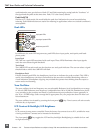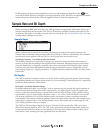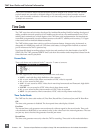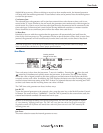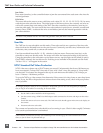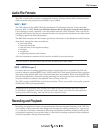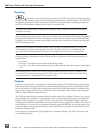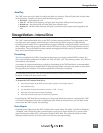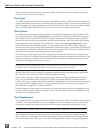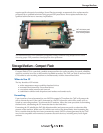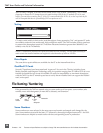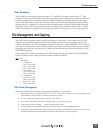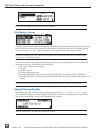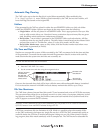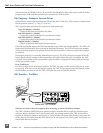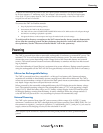
744T User Guide and Technical Information
32
firmware v. 1.04 Features and specifications are subject to change. Visit www.sounddevices.com for the latest documentation.
When selected from the setup menu, the repair utility will scan the drive for problems, report the
number of errors and correct the errors.
Drive Type
The 744T ships with a 2.5-inch ATA-5 interface, 4200 RPM hard drive. Sound Devices has chosen the
specifi c mechanism for maximum vibration and shock resistance. Most 2.5 inch drives conforming to
the ATA specifi cation can be substituted for the factory hard drive. When choosing a substitute hard
drive, note that higher RPM hard drives draw more current, reducing battery run time.
Drive Failure
Hard disk drives are mechanical devices and are susceptible to damage from physical shock. One
type of physical shock, called operating shock, occurs when the disk is in operation. During opera-
tion, the drive head is typically over the drive platters reading and writing data. When a physical
shock to the drive occurs during operation, the head and the platters can come into contact causing
both components to be damaged. The second type of shock, called non-operating shock, occurs
when the head is in the unloaded position, or not positioned over the platters. When a physical
shock occurs in the non-operating state, the head can contact the ramp it is positioned over and dam-
age the ability of the head to read and write data to the hard disk drive. All devices with hard drives
are subject to damage from operating and non-operating shock.
The mechanical construction of the 744T is designed to minimize the transmission of shock to the
hard drive. The drive is isolated from the chassis using special shock-reducing closed-cell foam. This
material increases the amount of shock the hard drive can withstand. Additional protection can be
achieved by operating the unit in a carry case.
If the recorder is used in applications subject to extreme motion, Sound Devices recommends recording to
CF medium only. The hard drive will park its write heads to reduce the chance of failure.
With all electrical devices, the higher the ambient temperature the shorter the device’s operational
life. Therefore, take care observe the specifi cied temperature rating.
There is also a risk from sudden temperature changes, which can create condensation inside the
drive. This condensation can lead to the drive’s read/write heads adhering to the disk surfaces
which will, in turn, stop the hard disk from rotating. Condensation tends to occur when the tempera-
ture inside the drive suddenly falls, for example, just after the unit is moved to a new position, or
after operation is stopped in a cold environment.
Sudden changes in temperature or air pressure can cause disk surface material to evaporate, which
can also cause the head to adhere to the disk surface. This can happen when a hard disk drive is left
unused for a long period of time.
Drive Replacement
The internal hard drive can be removed and replaced if the device fails or if a different capacity drive
is needed. The internal hard drive is not a swappable medium. Its multi-pin connector is not rated
for repeated insertion and removal cycles and may be prone to breakage with repeated cycling.
In typical service conditions Sound Devices recommends hard drive replacement once every three years.
The hard drive is mounted to the bottom-side of the recorder’s chassis and is screwdriver acces-
sible. The drive is “suspended” in the unit with a shock isolating membrane and is attached to the
main circuit board via a “fl ex board”. Since the unit’s high-density circuitry and tight construction



